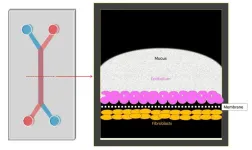(Press-News.org) Summer can be an extra challenging time for Texas’ 189 major water supply reservoirs. With temperatures consistently reaching 100 degrees or higher, reservoir evaporation rates see high increases.
Accurate evaporation rate estimates are crucial for water resource managers, as reservoirs play an essential role in our social and economic systems by supplying water for agricultural, municipal, and industrial consumption. Reservoirs are also critical for mitigating impacts from droughts and floods.
A recent study published in Water Resources Research highlights the efforts of Texas A&M University researchers Dr. Huilin Gao and Dr. Bingjie Zhao, with coauthors from multiple institutions, state, and federal agencies. The research team developed a more accurate method for estimating daily evaporation rates.
“This method will enhance decision-making processes related to reservoir operations, water rights allocation, and long-term water planning in Texas and beyond,” said Dr. Nelun Fernando, manager of Texas Water Development Board’s (TWDB) water availability department.
Zhao, Gao, and their team developed a new computer algorithm to estimate daily reservoir evaporation that accounts for factors not considered by current methods.
“If you look at our daily evaporation algorithm, it uses regular meteorological data like wind, temperature, and relative humidity, so it's a lot easier to calculate for each reservoir,” said Gao, a professor in the Zachry Department of Civil and Environmental Engineering.
According to the article, “long-term and consistent reservoir evaporation information is typically reported on a monthly scale. Accurate daily evaporation information is lacking, but it is crucial for hydrological scientific research and regional water resource management.”
The most common methods for estimating evaporation rely on data from Class A Evaporation Pans. These pans sit outside of the reservoir and estimate evaporation by measuring changes in the pan’s water level. The pan evaporation data is then converted to reservoir evaporation data using an adjustment factor known as pan coefficients.
Since evaporation pans are typically located away from the reservoir, they do not account for the effects of wind, water depth, or air and water temperature differences across the reservoir. This can lead to inaccurate measurements, creating uncertainty for water resource managers.
“The lakes are much deeper than the evaporation pans, causing the water temperatures to be very different,” said Zhao. “This means the evaporation rate predicted by the evaporation pan cannot represent the real lake accurately.”
At this time, the daily evaporation algorithm has only been applied to Texas reservoirs. The results reveal a clear geographic distribution and strong seasonality of evaporation throughout Texas, with highest average losses occurring in July. Additionally, the data reveals a significant upward trend in evaporation rate, with an increase of about 1.1 inch per decade.
Gao and Zhao collaborated with Desert Research Institute (DRI) to develop an online portal that allows stakeholders to visualize and download data in near-real time.
Due to the success of the algorithm’s estimation on Texas reservoirs, the research team is currently working on evaporation data for all major reservoirs in the western United States.
The paper was coauthored by researchers from DRI, TWDB, Lower Colorado River Authority (LCRA), U.S. Army Corps of Engineers (USACE) – Dallas-Fort Worth District, and U.S. Bureau of Reclamation.
This research was supported by USACE, TWDB, LCRA, and NASA.
By Alyssa Schaechinger, Texas A&M Engineering
###
END
Every drop counts: New algorithm tracks Texas daily reservoir evaporation rates
Texas A&M University researchers have developed a more accurate method for tracking reservoir evaporation rates that will improve water planning and management
2024-05-30
ELSE PRESS RELEASES FROM THIS DATE:
Study: Access to targeted lung cancer drug is cost-prohibitive globally
2024-05-30
MIAMI, FLORIDA (May 30, 2024) – Many countries with national healthcare systems or payers such as insurance companies use cost-effectiveness analyses to decide whether to cover new medicines, balancing treatment costs with potential health benefits.
That strategy often limits access to new, targeted therapies, even when these drugs prove highly effective and become part of standard-of-care therapy for many patients.
A new study from Sylvester Comprehensive Cancer Center at the University of Miami Miller School of Medicine examined the cost-effectiveness of durvalumab, a targeted immunotherapy for lung cancer that ...
Insilico Medicine President Alex Aliper, Ph.D. to present at Systems Aging Gordon Research Conference
2024-05-30
Alex Aliper, PhD, president of global clinical stage artificial intelligence (AI)-powered drug discovery company Insilico Medicine (“Insilico”) will present at the Systems Aging Gordon Research Conference, a leading international scientific conference focused on advancing the frontiers of science through the presentation of cutting-edge and unpublished research. On Wed., June 5, 10:40 am, Dr. Aliper will give a talk titled "Generative Artificial Intelligence and Next-Generation Robotics for Drug Discovery and Longevity Research."
The conference ...
ESA announces recipients of 2024 Awards
2024-05-30
The Ecological Society of America is pleased to announce the winners of its 2024 awards, which recognize outstanding contributions to ecology in new discoveries, teaching, sustainability, diversity and lifelong commitment to the profession.
These awards are designed to not only reward past achievements, but also to inspire a broad audience of scientists, educators and students, opening the door to new insights and collaborations that will further the impact of ecological research.
“The Ecological Society of America is immensely proud to honor this year’s distinguished awardees,” said ESA President ...
Novel mobile air monitoring technology yields greater insight into post-disaster pollution levels
2024-05-30
A team including researchers from the Texas A&M University School of Public Health and School of Medicine has found that high resolution mass spectrometry could be a valuable tool for identifying and assessing air-borne contaminants produced by natural and man-made disasters. Their findings were published in the Journal of Exposure Science & Environmental Epidemiology.
The scientists used high resolution mass spectrometry—a highly accurate means of identifying molecular compounds in a sample—in fall 2023 to identify volatile organic ...
Human cervix modeled in microfluidic organ chip fills key women's health gap
2024-05-30
Human cervix modeled in microfluidic organ chip fills key women's health gap
Engineered cervix with in vivo-like mucus production, hormone sensitivity, and associated microbiome creates novel testbed for bacterial vaginosis therapeutics and other treatments
By Benjamin Boettner
(BOSTON) — Bacterial Vaginosis (BV) has been identified as one of the many unmet needs in women's health and affects more than 25% of reproductive-aged women. It is caused by pathogenic bacteria that push the healthy microbiomes in the female vagina and cervix – the small gatekeeper canal that connects the uteruns and vagina – into a state of imbalance known as dysbiosis. ...
People are altering decomposition rates in waterways
2024-05-30
Humans may be accelerating the rate at which organic matter decomposes in rivers and streams on a global scale, according to a new study from the University of Georgia, Oakland University and Kent State University.
That could pose a threat to biodiversity in waterways around the world and increase the amount of carbon in Earth’s atmosphere, potentially exacerbating climate change.
Published in Science, the study is the first to combine a global experiment and predictive modeling to illustrate how human impacts to waterways may contribute to the global climate crisis.
“Everyone in the world needs water,” ...
Studied on social media: The real-world impacts of factual but misleading content & the characteristics of “supersharers”
2024-05-30
Factual yet misleading vaccine content was 46 times more effective at driving vaccine hesitancy than flagged misinformation, reports a new study exploring real-world impacts of misinformation exposure. A second study aiming to better understand the characteristics of “supersharers” – a small group of individuals increasingly found to spread misinformation – reports that just over 2,000 supersharers on X (formally Twitter) spread 80% of the fake news during the 2020 US presidential election; the study involved a sample of more than 660,000 voters on X and uncovered that the supersharers were mainly middle-aged Republican women in conservative states.
Misinformation, ...
Why some nest-invading cuckoo birds have higher rates of speciation
2024-05-30
Cuckoos – which lay their eggs in nests of other birds – have higher speciation rates when they lay their eggs in a broader range of host bird species’ nests, a new study reports. This higher speciation rate is driven by host rejection and cuckoo selection for mimetic nestling traits. How new species arise is a fundamental question in biology. Coevolution between closely interacting species is thought to increase biodiversity and potentially explain the vast number of distinctly specialized species. However, evidence linking macroevolutionary patterns to microevolutionary ...
Living bioelectronic device monitors and manages psoriasis in mice
2024-05-30
Coupling skin bacteria-laden hydrogel and electronics, researchers have introduced the ABLE platform, a bioelectronics system that can deliver management and adaptive treatment of skin inflammation. They test this approach in a mouse model of psoriasis. The findings demonstrate the potential for clinical application of bioelectronics devices that promote drug-free therapeutic effects through a living hydrogel interface. “This amalgamation of living and synthetic components is a notable advance toward ...
Model reveals global patterns of organic decomposition in rivers
2024-05-30
Integrating big data and a coordinated global field experiment, researchers have developed a model that can predict the decomposition rate of organic matter in rivers worldwide. The global model estimates decomposition rates in rivers across vast understudied areas of Earth, revealing rapid decomposition across continental-scale areas dominated by human activities. Earth's terrestrial ecosystems generate over 100 billion tons of plant detritus annually, with its fate – long-term storage, mineralization to greenhouse gasses, or incorporation into food webs – determined by decomposition rates. This organic material is continually added to rivers ...
LAST 30 PRESS RELEASES:
Jeonbuk National University study shows positive parenting can protect adolescents against self-harm
Surface-engineered ZnO nanocrystals to tackle perfluoroalkyl substance contamination
This new understanding of T cell receptors may improve cancer immunotherapies
A new fossil face sheds light on early migrations of ancient human ancestor
A new immunotherapy approach could work for many types of cancer
A new way to diagnose deadly lung infections and save lives
40 percent of MRI signals do not correspond to actual brain activity
How brain-inspired algorithms could drive down AI energy costs
Gum disease may be linked to plaque buildup in arteries, higher risk of major CVD events
Contrails are a major driver of aviation’s climate impact
Structure of dopamine-releasing neurons relates to the type of circuits they form for smell-processing
Reducing social isolation protects the brain in later life
Keeping the heart healthy increases longevity even after cancer
Young adults commonly mix cannabis with nicotine and tobacco
Comprehensive review illuminates tau protein's dual nature in brain health, disease, and emerging psychiatric connections
Book prepares K-12 leaders for the next public health crisis
Storms in the Southern Ocean mitigates global warming
Seals on the move: Research reveals key data for offshore development and international ecology
Sports injuries sustained during your period might be more severe
World's first successful 2 Tbit/s free-space optical communication using small optical terminals mountable on satellites and HAPS
Can intimate relationships affect your heart? New study says ‘yes’
Scalable and healable gradient textiles for multi‑scenario radiative cooling via bicomponent blow spinning
Research shows informed traders never let a good climate crisis go to waste
Intelligent XGBoost framework enhances asphalt pavement skid resistance assessment
Dual-function biomaterials for postoperative osteosarcoma: Tumor suppression and bone regeneration
New framework reveals where transport emissions concentrate in Singapore
NTP-enhanced lattice oxygen activation in Ce-Co catalysts for low-temperature soot combustion
Synergistic interface engineering in Cu-Zn-Ce catalysts for efficient CO2 hydrogenation to methanol
COVID-19 leaves a lasting mark on the human brain
Scientists use ultrasound to soften and treat cancer tumors without damaging healthy tissue
[Press-News.org] Every drop counts: New algorithm tracks Texas daily reservoir evaporation ratesTexas A&M University researchers have developed a more accurate method for tracking reservoir evaporation rates that will improve water planning and management



